About Riverside Public Utilities
Riverside Public Utilities (RPU) has been providing water and electricity to the City of Riverside, CA since 1895. As an innovative public utility serving 70,000 customers, RPU has developed a new initiative – Utility 2.0, a strategic plan that addresses big challenges that all utilities are facing today.
The Challenge
Some of these challenges that affect the delivery of safe drinking water include ageing infrastructure, climate change, new government regulations, aging workforce, and of course technology. Technology has a role to play in all these areas and Riverside is known for keeping ahead of the curve.

The Solution: WaterTrax
In 2007, when most municipalities relied on spreadsheets and pen and paper reporting, RPU implemented WaterTrax to consolidate and automate water quality sample data transfers from the laboratories. Included in the implementation was a thorough import and migration of historical data. Having State Certified Environmental Laboratories upload results they produce directly into WaterTrax, allows RPU to utilize WaterTrax as its secure database of record. There is no ability for the end user to edit an analytical result or accidentally make a typo as with a spreadsheet. WaterTrax’s user friendly interface gives RPU immediate access to the information in an organized useful format.
Out of the box report generating, archiving and trend analysis tools are utilized on a daily basis to fulfill data requests and to monitor treatment plant processes and raw water trends. WaterTrax streamlines regulatory compliance and provides alert notifications when parameters are under or over the set range, which allows the utility to geographically pinpoint trouble spots and enact corrective measures when needed.

In 2018 WaterTrax released a free API to existing customers, as a means to seamlessly integrate WaterTrax with 3rd party systems (e.g. BI tools, CMMS, GIS, etc.), in a secure and automated manner. As expected RPU was quick to jump on board and see how they could further improve efficiencies in operations and what improvements, if any, could be made with deeper data analytics.
Robin Glenney, Water Quality Administrator at Riverside Public Utilities, spearheaded the API adoption, along with the PI team. With a unique API key having been issued by WaterTrax to securely access the API, the utility was able to begin configuring the tool to appropriately map and subsequently trigger the transfer of hundreds of thousands of data points from a multitude of analytes associated with hundreds of sampling locations from WaterTrax into their internal OSISoft PI System. The entire process of integrating WaterTrax with the PI System, which included a stringent quality assurance testing process to ensure accuracy of data, was completed in less than six months.
The API integration has really improved our ability to quickly make decisions based on real time data. The advantage of combining information from SCADA, UWAM, and WaterTrax gives us the big picture in one place and allows us to improve performance and operational efficiency.

The Benefits
The API function enabled the transfer and ingestion of water quality data from WaterTrax into Riverside’s internal business intelligence tool, OSISoft PI System – a vehicle used for centralizing data sourced from other business units including SCADA, Esri GIS and Asset Management/Work Order System (UWAM). The integration enables RPU to view current data from systems that were previously siloed and isolated.
This integration has provided the utility with a more holistic view of their distribution system samples, treatment plant process control samples and groundwater well samples. Having all the data automatically funnel into a centralized system as it becomes available means staff no longer needs to manually extract data separately from WaterTrax, SCADA, and UWAM before performing subsequent data manipulation. This has made the process of data compilation and report generation much more efficient.
The integration of the OSISoft PI and WaterTrax has yielded other benefits to the utility and its key users. Visual displays can now be created and automatically updated as new data is made available. Moreover, dashboards are displayed on a secure site for operators and management to see in real time. This has had a significant impact on the operations team with respect to improving the efficiency of water quality management.

RPUs groundwater wells and treatment facility effluents blend prior to entering the distribution system. Real time data from SCADA and WaterTrax are integrated in a Blend Model dashboard, where over 500 calculations run real time and show operators the blend at each transmission main, as well as entering the distribution system. If there is a change to the blend that exceeds the established setpoints, the water quality team gets an email or text message alert. This allows the operational team to make timely and appropriate decisions.
Water quality data from WaterTrax and service requests from UWAM are plotted on a map in ESRI GIS and displayed on a dashboard allowing staff to visualize location of service calls alongside chlorine residuals and other water quality data.
“The API integration has really improved our ability to quickly make decisions based on real time data”, said Robin Glenney. “The advantage of combining information from SCADA, UWAM, and WaterTrax gives us the big picture in one place and allows us to improve performance and operational efficiency”, Glenney concluded.
Aquatic Informatics, the producers of WaterTrax, provide ongoing support and training for newly released features through regular software updates, ensuring that utilities get the most out of their data with the constant evolution of technology.
Solution Highlights
-
Centralized data to facilitate real-time data management, extraction and integration
-
Reduced errors by eliminating manual processes
-
Improved data access, reporting, performance and operational efficiency, for timely, appropriate decisions

